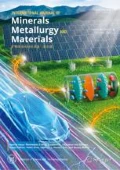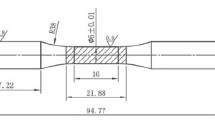Abstract
The fatigue cracking behavior of ultra-high strength steels containing rectangular inclusions of small sizes were investigated based on in situ observations by scanning electron microscopy (SEM). The size and shape of rectangular inclusions affect markedly the initiation site and propagation path of a fatigue crack. Especially, the initiation site of a fatigue crack depends strongly on the angle between the long-axis of a rectangle inclusion and the loading direction, and the length/width ratio of this rectangle inclusion because the residual stress distribution fields vary with these conditions. The results coincide very well with those of finite element analysis.
Similar content being viewed by others
References
Y. Tomita, Morphology of nonmetallic inclusions and mechanical properties of high strength low-alloy structural steels, Z. Metallkd., 87(1996), No. 3, p. 154.
Y. Tomita, Improved fracture toughness of ultrahigh strength steel through control of non-metallic inclusions, J. Mater. Sci., 28(1993), No. 4, p. 853.
Y. Murakami, S. Kodama, and S. Konuma, Quantitative evaluation of effects of non-metallic inclusions on fatigue strength of high strength steels: I. Basic fatigue mechanism and evaluation of correlation between the fatigue fracture stress and the size and location of non-metallic inclusions, Int. J. Fatigue, 11(1989), No. 5, p. 291.
Y. Tomita, Development of fracture toughness of ultrahigh strength low alloy steels for aircraft and aerospace applications, Mater. Sci. Technol., 7(1991), No. 6, p. 481.
X.S. Wang, F. Liang, Y.P. Zeng, and X.S. Xie, SEM in situ observations to the effects of inclusions on initiation and propagation of the low cyclic fatigue crack in super strength steel, Acta Metall. Sin., 41(2005), No. 12, p.1272.
Q.Y. Wang, C. Bathias, N. Kawagoishi, and Q. Chen, Effect of inclusion on subsurface crack initiation and gigacycle fatigue strength, Int. J. Fatigue, 24(2002), No. 12, p.1269.
Y.P. Zeng, H.M. Fan, X.S. Wang, and X.S. Xie, Study on micro-mechanism of crack initiation and propagation induced by inclusion in ultra-high strength steel, Key Eng. Mater., 353–358(2007), p. 1185.
X.S. Xie and Y.P. Zeng, The effect of inclusions on mechanical behaviour in ultra-high strength alloy steels, Mater. Sci. Forum, 654–656(2010), p. 51.
E.M. Patton and M.H. Santare, Effect of a rigid elliptical inclusion on a straight crack, Int. J. Fract., 46(1990), No. 1, p. 71.
F. Erdogan, G.D. Gupta, and M. Ratwani, Interaction between a circular inclusion and an arbitrarily oriented crack, J. Appl. Mech., 41(1974), No. 4, p. 1007.
M.H. Santare and L.M. Keer, Interaction between an edge dislocation and a rigid elliptical inclusion, J. Appl. Mech., 53(1986), No. 2, p. 382.
A. Roatta and R.E. Bolmaro, Eshelby inclusion-based model for the study of stresses and plastic strain localization in metal matrix composites: I. General formulation and its application to round particles, Mater. Sci. Eng. A, 229(1997), No. 1–2, p. 182.
M. Isida and H. Igawa, Analysis of a zig-zag array of circular inclusions in a solid under uniaxial tension, Int. J. Solids Struct., 27(1991), No. 12, p. 1515.
X.Q. Feng and S.W. Yu, Qusai-micromechanical constitutive theory for brittle damaged materials, Acta Mech. Solida Sin., 14(2001), No. 3, p. 200.
I.S. Raju and J.C. Newman Jr., Stress-intensity factors for a wide range of semi-elliptical surface cracks in finite-thickness plates, Eng. Fract. Mech., 11(1979), No. 4, p.817.
Author information
Authors and Affiliations
Corresponding author
Rights and permissions
About this article
Cite this article
Zeng, Yp., Fan, Hm. & Xie, Xs. Effects of the shape and size of rectangular inclusions on the fatigue cracking behavior of ultra-high strength steels. Int J Miner Metall Mater 20, 360–364 (2013). https://doi.org/10.1007/s12613-013-0735-2
Received:
Revised:
Accepted:
Published:
Issue Date:
DOI: https://doi.org/10.1007/s12613-013-0735-2




